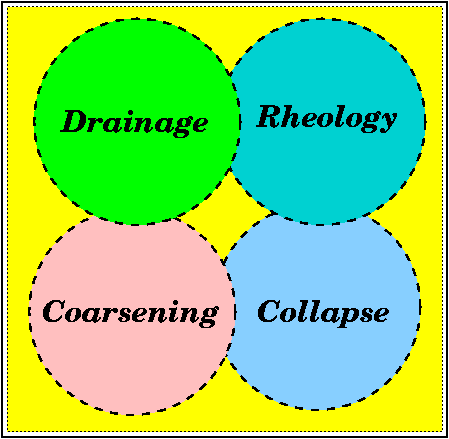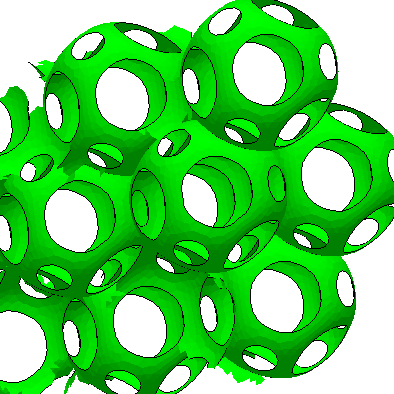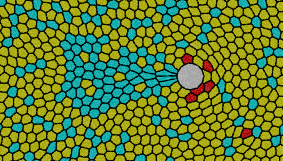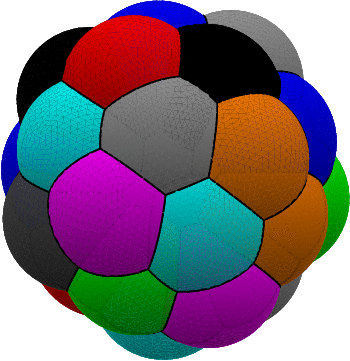Simon Cox: Research on Foams
Possible PhD/Masters/Summer research projects
Motivation
My research interests involve the study of foam, an example of soft condensed
matter. I am interested in modelling structural and dynamic properties of
collections of bubbles to be able to predict their response in various
applications.
For example, every time you drink a pint of beer, take a bath, or wash up your dishes, you are hoping that the foam will increase your enjoyment and/or the effectiveness of the process. How
does the size of the bubbles affect their lifetime? When you eat bread or chocolate mousse, you want it to be formed from lots of small bubbles rather than one large one (as you
sometimes see in a loaf of bread). How do you control the bubble size or get the foam into the mould?
Industrially, metallic foams are made in method similar to the baking of
bread. Liquid foams are used in the petroleum industry to push oil out of
the porous rocks in which it is found. In the mining industry, metal ores
are separated from rock by forcing bubbles through the mixture to form a
foam which carries the ore away, a process
known as froth flotation.
Modelling Foams
There are therefore many reasons why it is worthwhile to develop an understanding of the behaviour of foams under various conditions.
First, one needs to understand their structure, which can be viewed as rather mathematical minimal perimeter problems or
physics-inspired 3D geometric calculations. Then, there are a number of dynamic
phenomena.

In trying to progress to understand how foams respond, I separate the
various things that can happen to them into four processes.
- Drainage - the motion of liquid through the foam, usually due to gravity. It is therefore the network of liquid channels between the bubbles, coloured green in the
picture below, that are important. I am involved in a project that aims to understand how the liquid moves through a foam which is in a microgravity environment - it generally wants
to redistribute itself evenly.

- Rheology - the flow of the whole foam in response to an
applied force. There are lots of videos here. I use Brakke's Surface Evolver to perform
simulations of flowing foams in which details about each bubble are
available (in contrast to a continuum model). I aim to answer questions
about how a foam moves past an obstacle, for example when insulation foam
has to flow past the handle mount when filling a fridge door, or in a
variety of industrial processes in which foam is transported. In the image
below, bubbles move past a ball, coloured grey, from left to right, with
colour representing their pressure (you can also see a video of a simulation in which the foam is
pushed past a fixed ball). The wake affects the force that the foam exerts
on the ball, which in turn relates to the force that must be applied to
push the foam along. I also want to understand what role the
viscosity of the foam plays.

- Coarsening - the change in structure due to gas diffusion
across the soap films. This leads, in general, to large bubbles (with many
faces) growing at the expense of small bubbles. In two-dimensions there is an exact law, due to von Neumann, but in 3D current research effort is directed towards finding a similar law, and determining the statistical properties of the evolving foam. In this context, I use the Surface Evolver to investigate the structure of clusters of bubbles, as shown below. This software gives all the information necessary to determine the growth-rate of a bubble, and allows me to simulate the evolution of the foam in time.

- Collapse/Coalescence - the bursting of soapfilms, when they get very thin, or dirty, leads to two bubbles coalescing. If this continues, the whole foam collapses.
Sometimes one wishes to be able to collapse a foam quickly, when it is an undesired product of a process. At other times, severe coalescence is detrimental. What remains to be
understood is how to relate the coalescence characteristics of a single soap film in controlled conditions to the behaviour of a similar film immersed in a flowing or draining foam.
We recently looked at the recoil of adjacent films after a single coalescence event, in a two-dimensional foams (i.e. a foam squashed between two glass plates). See what happens when
the red film is deleted:

Possible PhD/Masters/Summer research projects:
- Wet foams and liquid drainage: there are two parts to this work, involving (i) the solution, numerically or otherwise, of the differential equations governing the flow of liquid through a foam, and (ii) examination of the complex structure of a wet foam and relating it to projected images of real foams.
- Modelling of two-dimensional flowing foams: this project
involves simulating the flow of foams inside a Hele-Shaw cell or a
microfluidic device using the Surface Evolver software. It will
investigate the domains of applicability of quasi-static models and the
recent Viscous Froth Model, which includes viscous effects due to drag
along the bounding plates of the cell. Possible geometries include flow
around objects such as discs, and flow through contractions and narrow
channels. The results will be related to experimental measurements with
the aim of predicting the behaviour of foam in, for example, filling and
extrusion processes.
- Optimal structure of area-minimizing networks: a foam minimizes its surface area subject to constant bubble volumes. This project will investigate the structure that
the foam takes to do so, with the aim of finding the configuration with the least area in a range of geometries (see examples here).
If you are interested, get in touch with me.
Contact details are on my home page
The information provided on this and other pages by me, Simon Cox, is under my own personal responsibility and not that
of Aberystwyth University. Similarly, any opinions expressed are
my own and are in no way to be taken as those of A.U.








